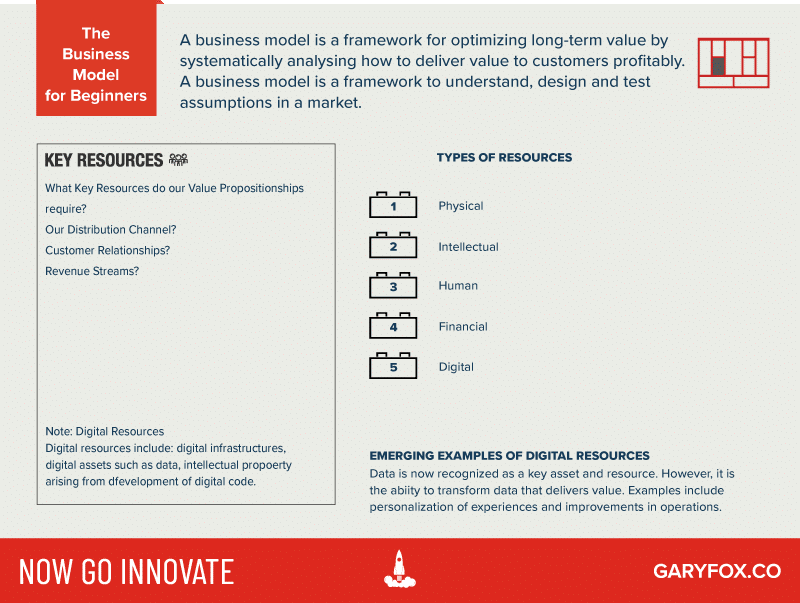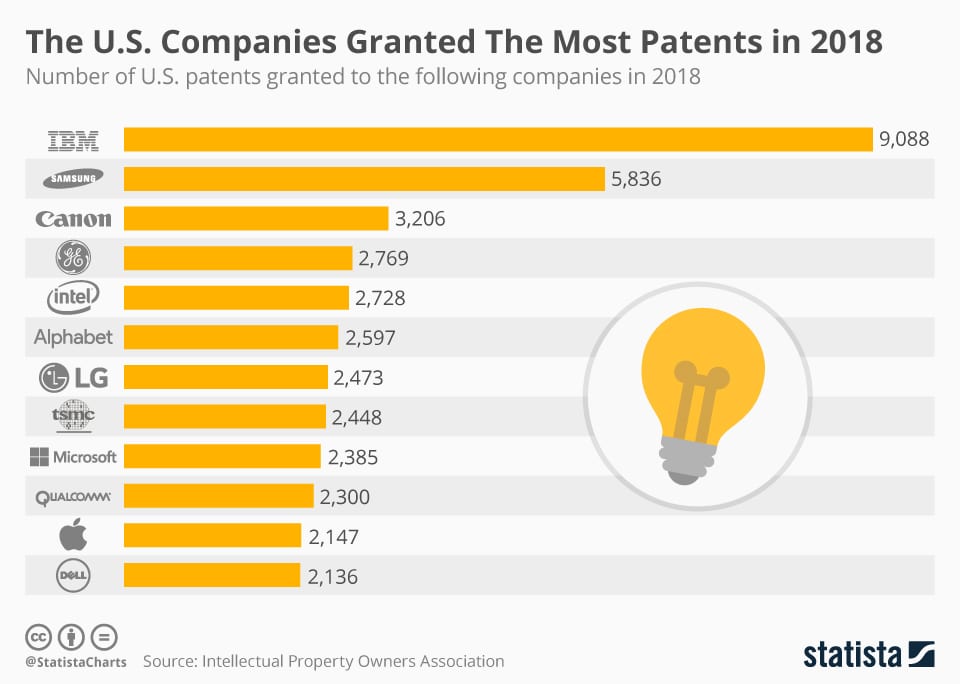In this section, you’ll learn what types of key resources you will need, how to map out the resources to achieve your value proposition and different types of resources for different types of businesses and markets.
It’s important to start off your business with the right resources to help your business to succeed. Of course, not all resources are the same. You will need resources for marketing, operations, finance as well as creating your product or service.
If you don’t have the right resources mapped out you’re business is likely going to get off to a bumpy start.
Table of Contents
Key Resources for Your Business Model

What are Key Resources?
Key Resources are the main assets that your company needs to create the end product. How and what resources you need and how you source them can dramatically affect your overall business model.
Key resources depend entirely on the type of business. As an example, while Apple designs their laptops they do not own the factories that make them. Apple has Key Partners that own factories and make their laptops, iPhones, iPads and Macs.
Key resources can be thought of in a number of ways and I’ll break these down into common business language so you can think about them.
What are the five key resources you need for your business?
The main key resources for your business are:
- Financial Resources
- Physical resources.
- Intellectual resources.
- Human resources.
- Digital resources
Types of Resources
1. Financial Resources
Probably the most important resource you need is money. Another term for money is capital. When you start out you need to buy things, even simple things that help you get your business off the ground:
- Branding – design, logo, graphics, business cards
- Office – rent, furniture, office equipment, storage
- Web – website hosting, collaboration software, email hosting and other essential software and tools.
- Employees – money for salaries, tax, healthcare…
- Expenses – travel, meetings, food, hotels…
- Insurance – insure your business against normal risks.
- Accountant – these may be outsourced or internal.
- Project Management Tools – software for managing projects.
- Marketing – the marketing mix you use will depend on the type of business e.g. B2B vs B2C and market sector.
- web analytics
- PR
- SEO
- Webinars
- Content Marketing
- Raw materials/goods – these are the basic materials you need to buy to make your final value offering. Some examples:
- Restaurants buy food to turn into meals that people buy.
- Fabric – fashion (if they make it themselves) buy fabric that they then turn into clothes.
- Knowledge into reports – a company might collect data and then transform this into reports.
- Distribution – there are numerous ways of changing the traditional way of managing logistics/distribution. The traditional ways are:
- transportation of raw materials and goods
- transportation of finished products and services
This is not meant to be an exhaustive list only a brief illustration of what you need to consider. A critical point to make is that at an early stage of a startup you are not making money so you need capital investment to pay for all your key resources.
Often partners are used instead of you needing capital costs for producing something yourself. As an example, the fashion industry uses partners to produce clothes, consumer electronics companies often outsource production to key partners…
2. Physical Resources
Physical assets are tangible resources that a business uses to create its value proposition. These could include:
- equipment
- inventory
- buildings
- manufacturing plants
- distribution networks
A car manufacturer company like BMW needs specialized production plants as a key resource. These production plants require land, equipment, buildings and other infrastructure. In order to innovate though many car manufacturers have transformed how they organize and use their physical resources. As an example, car manufacturers use robots in their production process to improve accuracy, speed of production and lower costs.
3. Intellectual resources.
These are intangible resources like Intellectual Property (IP), brand, patents, copyrights and partnerships.
For industries like consulting and advertising the intellectual property, and in fact, the people, are key resources. At 5.30 pm all of the key resources for an advertising company leave the building. The people have the know-how, skills, customer knowledge and understanding of how the business works. Because the business doesn’t and can’t own these people, it has to have legal contracts in place to protect itself.
Brands are an intangible key resource that has a monetary placed against them. Brands like Apple, Nike and Gillette have invested huge sums of money creating their brand and fostering how people perceive their brand. The name, logo and use of the brand, therefore, is a significant intangible resource that they can use when marketing new products.
Software is a good example of a digital resource that often takes years to code and perfect. Companies like Adobe, Slack, Google and Microsoft have invested millions of dollars to create, maintain and support them. Many of these companies protect their intellectual property through patents.
As you can imagine the number of patents filed each year is a good indication of the pace of innovation and change in technologies.

Increasingly companies realize the significance of intellectual resources as can be seen through the increase in patents filed in the United States. Companies understand that patents as a major driver of their business and growth and secure potential future revenue streams.
4. Human Resources
Employees are the most valuable key resources of most companies. Not only do employees help run the business, but they also interact with customers, help develop the business through innovating and hold the skills and knowledge that differentiates the business from another.
For businesses that provide services, people are the most important resource. Examples of the importance of people as a resource can be seen across different industries:
- Hospitality industries:
- Food and beverages.
- Travel and Tourism.
- Lodging.
- Recreation.
- Services:
- Media
- Healthcare
- Finance
- Banking
- Investment
- Insurance
- Consulting
- Design
- Sales and Marketing
- Research:
- scientific research
- engineering
- design
- medical
What makes people so important in these industries is that they involve high-levels of customer interaction, information (often tailored to the customer), creativity and customization.
How Key Resources Link To The Value Proposition
The type and characteristics of a companies key resources determine how well a company can fulfil its value proposition. For example in the case of an airline company, if the value proposition is their ease of travel, then providing an app will be a key part of the value proposition. The app could hold your booking, allow you to book your seat, receive notifications about changes to your flight, hold your e-ticket and allow you to easily communicate with a customer. This, in turn, means that the travel company would need:
- financial resources to invest in the development of such a system.
- human resources to develop it.
- intellectual resources for its development and subsequently to protect it – IP.
Similarly, the top designer in a company like Ferrari has functional value, as well as their value in terms of how customers and competitors view Ferrari. Hence, if a top designer leaves a company like Ferrari, it impacts how consumers and competitors view the future of the company and its cars.
Key Resources and Types of Businesses
The business model canvas proposes that there are three main types of business that relate to the overall business model:
- Product Driven Businesses
- Scope Driven Businesses
- Infrastructure Driven Businesses
1. Product Driven Businesses
These are companies that create and sell products. A product needs to be unique and meet the needs of a defined customer segment who are willing to buy it. Key resources for product-driven businesses are both intellectual and human. Typically these companies have expertise in their particular niche. Rovio, the creator of the famous mobile game called Angry Birds is one such example.
2. Scope Driven Businesses
These are focused on providing a value proposition to a particular customer segment. Another marketing term for these types of business is niche businesses. Generally, a scope-driven business will have specialized in serving a particular customer segment and have consequently developed and honed their resources to create value.
As an example, although an IT company that specializes in Human Resources software and has over year developed the knowledge, people and software to create value for their customers.
3. Infrastructure Driven Businesses
These, as the name suggests, achieve their value proposition through leveraging their developed and implemented infrastructure. The telecommunications industry invests heavily in developing the telecommunications infrastructure in a country and then reaps the rewards for years with only minor investments to keep their systems updated.
Google developed a global IT infrastructure to enable fast and effective searches. Gooogle then realized it could use this infrastructure, and knowledge, to offer web hosting and specialized services e.g. AI to other companies and a generate significant revenue stream.
Common Mistakes
Many entrepreneurs fail to think strategically about key resources and how they deliver the value proposition. Instead, they come up with generic resources that would be common in any business in the industry they are operating in.
It is imperative at this point to do an evaluation of each of the key resources listed on the canvas and check whether the resource mentioned is essential to the success of the business or not.
For example, talented human resources are a necessity for most businesses. The goal is to be creative and think of ways that you can use resources, or combinations of resources, in ways that are different from the dominant business model in a market or industry.